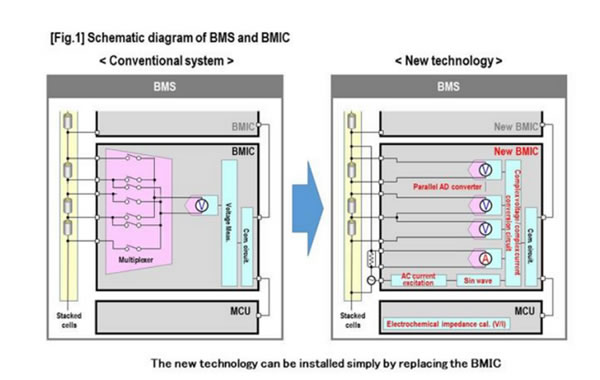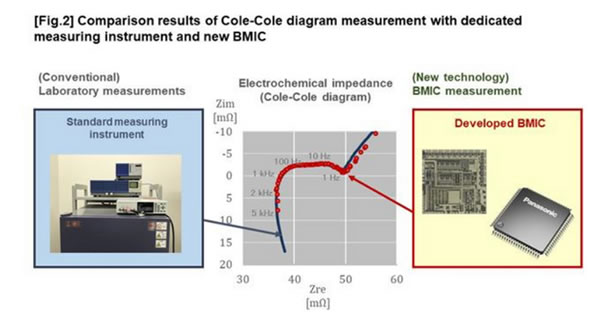
(Source: Panasonic official website)
According to foreign media reports, Panasonic has developed new battery management technology to measure the electrochemical impedance of the battery and effectively evaluate the residual value of the stacked lithium-ion battery pack. It is expected to be used in vehicles in the future. Panasonic developed this technology in collaboration with Professor Masahiro Fukui of Ritsumeikan University. Panasonic developed a new battery monitoring IC (BMIC) test chip, measurement algorithm and software. Ritsumeikan University uses batteries to evaluate actual performance.
The new battery management technology uses alternating current excitation to measure the electrochemical impedance of stacked lithium-ion battery modules. In addition, the residual value is evaluated through degradation diagnosis and fault evaluation based on the measured data. This will help promote the recycling of lithium-ion batteries and achieve sustainable development.
This new technology has the following characteristics:
1. Through BMIC technology, measure the electrochemical impedance of multi-cell battery packs.
The traditional BMIC can measure the voltage of a lithium-ion battery pack formed by stacking 6 to 14 cells. In the battery management system, multiple BMICs can be used to obtain voltage data from more series-connected battery cells (up to 200) to monitor the battery operating status and ensure safe use. In addition, you can also evaluate the charging and health status, and calculate the remaining cruising range and time.
In addition to traditional functions, the newly developed BMIC test chip also has a built-in electrochemical impedance measurement function, which uses alternating current excitation method for measurement. The electrochemical impedance measurement is achieved by 15 fully parallel analog / digital converters, a pulse modulation AC excitation circuit from 0.1 Hz to 5khz, and a complex voltage / complex current conversion circuit built into the BMIC. Therefore, the BMIC chip can measure the electrochemical impedance of the battery during operation without the need to make major adjustments to the BMS configuration in the current battery.
2. When performing electrochemical impedance measurement, the same measurement accuracy as the standard instrument is achieved.
By measuring Cole-Cole plots drawn with complex impedances, state assessment is performed using electrochemical impedance spectroscopy. Ritsumeikan University used BMIC and measurement software developed by Panasonic Corporation to measure cylindrical lithium-ion batteries. The results show that the Cole-Cole chart can be measured and drawn in the frequency range of 1 Hz to 5 KHz, and achieves the same accuracy as the standard measuring instruments for industry.

3. Respond to temperature changes of operating equipment through temperature calibration technology.
The electrochemical impedance of lithium-ion batteries is very sensitive to temperature changes. Therefore, when using special measuring instruments in the laboratory for measurement, the battery should be placed in a constant temperature room to maintain a constant temperature. As for the battery module during operation, stable environmental impedance measurement cannot be performed due to continuous changes in the ambient temperature. Therefore, Ritsumeikan University and Panasonic Corporation of Japan have developed a temperature correction technique. During the process of electrochemical impedance measurement, the temperature of the lithium-ion battery is measured, and the impedance temperature change is corrected to the standard temperature, which is plotted on the Cole-Cole diagram. In this way, even if the environmental temperature changes with the change of season and time, it can be corrected to the standard temperature in the database according to the Cole-Cole chart.
The new technology is suitable for equipment and vehicles with multi-cell lithium-ion batteries, such as electric bicycles, low-speed vehicles, construction and logistics machinery, etc., and can be used in electric vehicles and large-capacity batteries in the future. (Author: Elisha)
HEX SOCKET HEAD CAP BOLT: also called Allen Bolt, consisting of the head ( head is hexagonal and cylindrical) and the rod (cylinder with external threads) ,usually uesd together with nut.washer.
According to clients' demands, material can be Stainless Steel SS304/316/316L, Duplex Steel S32750/32760/2205/NAS660/904L..
The Standard is various, main standard is DIN/ANSI/GB, of course we also can accept JIS/BSW
Raw material should be cut in concrete length and processed by Cold/hot forge.surface finish,then can become various size fasteners.
Our Stainless Steel fasteners have great quality and are widely used in Heavy Industry.Shipping Industry. Construction Industry.Chemical Industry and Marine Industry.
Hex Socket Head Cap Bolt is one of our advantage Products. Chinese Manufacture, Qualified Hardware and Fasteners, Different size/Diameter/Tooth pitch, we all can satisfy your demands.

Cup Head Bolt,Hexagon Head Bolt,Hexagon Socket Bolt,Hex Socket Head Cap Bolt
Taizhou Risco Stainless Steel Products Co.,Ltd , https://www.riscofastener.com
